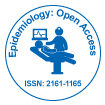మా గ్రూప్ ప్రతి సంవత్సరం USA, యూరప్ & ఆసియా అంతటా 3000+ గ్లోబల్ కాన్ఫరెన్స్ ఈవెంట్లను నిర్వహిస్తుంది మరియు 1000 కంటే ఎక్కువ సైంటిఫిక్ సొసైటీల మద్దతుతో 700+ ఓపెన్ యాక్సెస్ జర్నల్లను ప్రచురిస్తుంది , ఇందులో 50000 మంది ప్రముఖ వ్యక్తులు, ప్రఖ్యాత శాస్త్రవేత్తలు ఎడిటోరియల్ బోర్డ్ సభ్యులుగా ఉన్నారు.
ఎక్కువ మంది పాఠకులు మరియు అనులేఖనాలను పొందే ఓపెన్ యాక్సెస్ జర్నల్స్
700 జర్నల్స్ మరియు 15,000,000 రీడర్లు ప్రతి జర్నల్ 25,000+ రీడర్లను పొందుతున్నారు
ఇండెక్స్ చేయబడింది
- ఇండెక్స్ కోపర్నికస్
- గూగుల్ స్కాలర్
- షెర్పా రోమియో
- జెనామిక్స్ జర్నల్సీక్
- సేఫ్టీలిట్
- వ్యవసాయంలో గ్లోబల్ ఆన్లైన్ పరిశోధనకు యాక్సెస్ (AGORA)
- సెంటర్ ఫర్ అగ్రికల్చర్ అండ్ బయోసైన్సెస్ ఇంటర్నేషనల్ (CABI)
- RefSeek
- హమ్దార్డ్ విశ్వవిద్యాలయం
- EBSCO AZ
- OCLC- వరల్డ్ క్యాట్
- CABI పూర్తి వచనం
- క్యాబ్ డైరెక్ట్
- పబ్లోన్స్
- జెనీవా ఫౌండేషన్ ఫర్ మెడికల్ ఎడ్యుకేషన్ అండ్ రీసెర్చ్
- యూరో పబ్
- ICMJE
ఉపయోగకరమైన లింకులు
యాక్సెస్ జర్నల్స్ తెరవండి
ఈ పేజీని భాగస్వామ్యం చేయండి
నైరూప్య
The 2009 Lebanese National Mammography Campaign: Results and Assessment Using a Survey Design
Loulou Kobeissi, Rasha Hamra, Goleen Samari, Mohammad Khalifeh, Leila Koleilat
Background: Breast cancer screening and early detection lead to better prognosis, survival rates and quality of life. The Lebanese Ministry of Public Health (MoPH) organizes yearly national-subsidized mammography campaigns in October, since 2002. This paper describes the characteristics of women attending the 2009 MoPH mammography campaign and explores factors influencing their first-time participation.
Materials and Methods: Data from 83 mammography centers on 10,953 women (gathered during October- December 2009) were analyzed. The data were collected by the radiology technicians at the centers, using a closedended questionnaire. Data management and analysis was done using SPSS. Analysis included descriptive, bi-variate statistics and backward logistic regression.
Results: The mean age of women attending the campaign was 49 (SD 9.67) years. 84.1% of the women were married, 13.6% had some form of university education, and 40.7% were current smokers. 82.9% indicated to have ever breast fed, and 36.9% were current or ever users of OCP. As for family history, 8.9% indicated to have an aunt on the mother’s side with breast cancer, 8.8% have a sister, 7.5% an aunt on the father’s side, and 7.3% have a mother. 68.2% of the women participated in the campaign for the first time. 97.8% indicated they would repeat the exam next year. 88.8% considered the price acceptable. 51.6% had normal diagnosis. Television messages and a friend were the two most common routes via which the woman heard of the campaign. Women who participated in the campaign before compared to those participating for the first time: were more likely to be independently-significantly: older, of higher educational levels, non-smokers, and with a family history of breast cancer.
Conclusion: Such an assessment is important in order to enhance outreach as well as identify factors that could contribute to better service delivery, capacity and quality.
సబ్జెక్ట్ వారీగా జర్నల్స్
- ఆహారం & పోషకాహారం
- ఇంజనీరింగ్
- ఇన్ఫర్మేటిక్స్
- ఇమ్యునాలజీ & మైక్రోబయాలజీ
- ఎకనామిక్స్ & అకౌంటింగ్
- కంప్యూటర్ సైన్స్
- కెమికల్ ఇంజనీరింగ్
- క్లినికల్ సైన్సెస్
- గణితం
- జనరల్ సైన్స్
- జియాలజీ & ఎర్త్ సైన్స్
- జెనెటిక్స్ & మాలిక్యులర్ బయాలజీ
- నర్సింగ్ & హెల్త్ కేర్
- పర్యావరణ శాస్త్రాలు
- ఫార్మాస్యూటికల్ సైన్సెస్
- బయోకెమిస్ట్రీ
- బయోమెడికల్ సైన్సెస్
- భౌతిక శాస్త్రం
- మెటీరియల్స్ సైన్స్
- మెడికల్ సైన్సెస్
- రసాయన శాస్త్రం
- వెటర్నరీ సైన్సెస్
- వ్యాపార నిర్వహణ
- సామాజిక & రాజకీయ శాస్త్రాలు
క్లినికల్ & మెడికల్ జర్నల్స్
- అంటు వ్యాధులు
- అణు జీవశాస్త్రం
- అనస్థీషియాలజీ
- ఆరోగ్య సంరక్షణ
- ఆర్థోపెడిక్స్
- కార్డియాలజీ
- క్లినికల్ రీసెర్చ్
- గ్యాస్ట్రోఎంటరాలజీ
- జన్యుశాస్త్రం
- టాక్సికాలజీ
- డెంటిస్ట్రీ
- డెర్మటాలజీ
- నర్సింగ్
- నెఫ్రాలజీ
- నేత్ర వైద్యం
- నేత్ర వైద్యం
- న్యూరాలజీ
- పల్మోనాలజీ
- పీడియాట్రిక్స్
- పునరుత్పత్తి ఔషధం
- ఫిజికల్ థెరపీ & పునరావాసం
- మందు
- మధుమేహం & ఎండోక్రినాలజీ
- మనోరోగచికిత్స
- మైక్రోబయాలజీ
- రేడియాలజీ
- రోగనిరోధక శాస్త్రం
- సర్జరీ
- హెమటాలజీ

 English
English  Spanish
Spanish  Chinese
Chinese  Russian
Russian  German
German  French
French  Japanese
Japanese  Portuguese
Portuguese  Hindi
Hindi